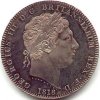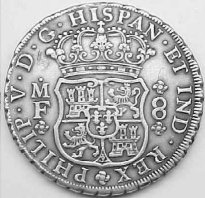During this period of New Brunswick's existence (1786-1835), as a British colony, money of account was the pound, expressed as £ s. d. (£ pounds), (s. shillings), and (d. pence), £ / / , or £ - - . Bills of exchange were drawn, books and statements of account were kept, and legal and business transactions expressed in this "money of account."
The money in circulation, notably Spanish colony silver, as well as Dutch, German, Portugese, and coins of other nations, was accepted as legal tender at equivalent value.
With few exceptions, bequests, as well as estate inventories, were expressed in the form of pounds, shillings and pence, "New Brunswick Currency." Occasionally, Sterling, "Halifax Currency" and "New York Currency" were specified.
 1767 Guinea
1767 Guinea |
Sterling
[Click images for larger version.]
|
 1818 Crown
1818 Crown |
The British pound (pound Sterling) was the monetary unit of Great Britain. In pre-decimal days, the pound was divided into 20 shillings, each shilling worth 12 pence. Thus, there were 240 pence in a pound. The other common references to British money were the Guinea, equal to 21 shillings, and the Crown, equal to 5 shillings.
While Sterling was the money of account for transactions between Britain and the North American colonies, there seems to have been relatively little British coinage actually in circulation in any of the colonies, either before or immediately after the American Revolution, due mainly to the imbalance of trade with Great Britain, and the scarcity of silver in England available for coinage.1
 8 Reale - obverse
8 Reale - obverse |
Spanish Milled Dollars
[Click images for larger versions.]
|
 8 Reale - reverse
8 Reale - reverse |
Spain established a mint in Mexico in the late 1530s, and a great portion of the money in circulation in colonial America was hammered reale coins of various denominations. Coin-making machinery existed in Europe in the mid-1600s, but it was not until 1732 that the Mexican mint began production of pressed, milled-edge coins, as illustrated above, production continuing until 1826, in denominations of 8-reale, 4-reale, 2-reale, 1-reale and a half-reale, or picayune. The silver 8 reale coins, known also as the Piece-of-eight or peso, were commonly called Spanish milled dollars. Based on fineness and content, the value of the Spanish colony 8 reale piece was about equal to the Dutch rijksdaalder and German reichsthaler, or "rix dollars."
Rigid adherence to standards of purity and weight made the coinage of Spain, and the Spanish colonies in the New World, the standard by which that of other nations was measured. The Spanish dollar was deemed, by the London Mint, to be valued at 4s. 6d. (or 54 pence) Sterling, but the dollar was valued substantially higher in the British colonies in North America, varying from colony to colony, over a range from 5 to 8 shillings, depending on the time and the particular colony. For example, the 8-reale coin, in the early 1700s, was valued at 96 pence in New York, 65 pence in Virginia, 84 pence in Massachusetts, and 94 pence in Pennsylvania, despite the fact that the colonial value of the Spanish dollar was proclaimed, in 1704, as 6s. (72 pence), and that value fixed by Parliament in the coinage act in 1708.
Haliax Currency
In Nova Scotia, the value of the Spanish dollar was fixed, by an Act of the Legislature, in 1759, at 5 shillings, the foundation of "Halifax Currency." Horace A. Flemming's detailed paper on that subject, published in the "Collections of the Nova Scotia Historical Society," Vol. XX, 1915, pp. 111-137, is included here, and neeeds no further comment.
New Brunswick Currency
Neither "Halifax Currency" nor "New Brunswick Currency" was money minted in the respective province; rather, both were expressions of the value, in pounds, shillings and pence, applied to the various monies then in circulation, both British and foreign, any and all of which were considered legal tender.
At the first session of the New Brunswick Legislature, in January, 1786, an Act2 (C.16 Anno XXVI. Geo. III.) was passed establishing the value of the English guinea, to "pass current and be received" for 23s. 4d.; silver English or French crowns at 5s. 6d., "and all other English gold and silver coin in the like proportion. Spanish milled dollars were valued at 5s., and half-Johannes at 40s. This would appear to indicate those specifically mentioned in the Act were the common coins in circulation within the new province.
In 1805, the Legislature passed another Act (C. 4. Anno XLV. Geo. III.), establishing values for gold coins then in circulation in the province, particularly the Portugese Moidore, Spanish Doubloon, the French Louis d'or and Pistole, and the American Eagle. Although this Act was subsequently disallowed by the King in Council, it serves to show these coins were in circulation in the Province at that time, and their commonly accepted values.
Evidently no further action by the Legislature of New Brunswick was considered necessary until England adopted the gold standard in 1816, and, in the process, revalued silver. The guinea was eliminated from coinage, thereafter existing only as a money of account. The guinea coin was replaced with the gold Sovereign, a lighter coin, valued slightly less, at £1 (20s.).3.
The New Brunswick Legislature passed a third Act (C. 23, Anno LVIII. Geo. III.) on 11 March, 1818, providing that the new coins of the United Kingdom were legal tender, setting the value of the gold sovereign at 22s. 3d., and the new silver Crown at 5s. 6d. in New Brunswick. From the preamble to this Act, it seems that doubt existed whether the new coins could be considered legal tender under the provisions of the first Act cited above. This Act incorporated a suspending clause: "And be it further enacted, That this Act shall not be in force until His Majesty's Royal approbation be had and declared to the same," thus requiring Royal assent before becoming law. The Act was finally confirmed by order of the King in Council, 1 February, 1821, and published and declared in New Brunswick on 5 June, 1821.
Thus the new issue of English silver crowns was established equal in value to the old issue, as well as the silver French crown, and the silver dollar of the United States valued at 5s., on par with Spanish milled dollars.
An Act, passed 29th March, 1820, appears to have established different values for some foreign coins, as indicated by another Act, passed in 1826, which repealed it. Unfortunately, the text of the 1820 Act is not available, and there is no further mention in the Acts of the General Assembly concerning currency, foreign or British, until 1835, when an Act was passed setting the value of "Spanish milled dollars, Mexican dollars, Peruvian dollars, Chilian dollars and the dollars of Central America," at 5 shillings each, and making them legal tender in the Province.
——————————
1. Mackay, James, A History of Modern English Coinage Henry VII to Elizabeth II, Longman, London, 1984, ISBN 0-582-50311-6, pp. 113, 118.
2. Legislative Library, Fredericton, New Brunswick. Copies of the cited Acts were provided by Jean-Claude Arcand, Technical Services Librarian.
3. Mackay, James, A History of Modern English Coinage Henry VII to Elizabeth II, pp. 130-1.